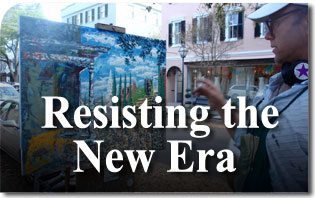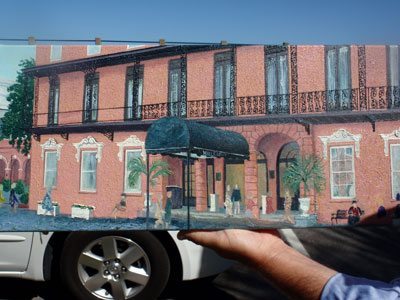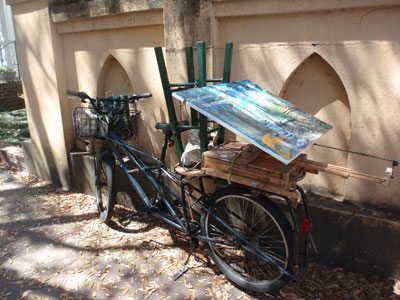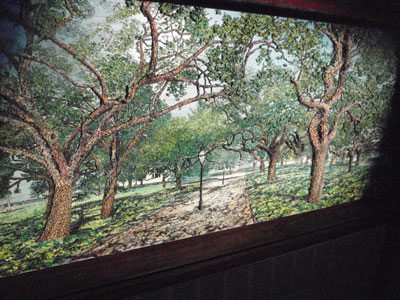 “If you love what you do,” the saying goes, “you will never work a day of your life.” Few people in today’s hectic world could say that, but on a recent trip to Charleston, South Carolina, I found one who can. His name is David Anthony Babb but is known in the art world simply as DAB.
“If you love what you do,” the saying goes, “you will never work a day of your life.” Few people in today’s hectic world could say that, but on a recent trip to Charleston, South Carolina, I found one who can. His name is David Anthony Babb but is known in the art world simply as DAB.
It was a sunny spring day when I bumped into him on Meeting Street. His easel was strategically set up across from the Mills Hotel. This inn has been treating guests to good ole Southern Hospitality for over 150 years1 and DAB was quietly, and one could say lovingly, recreating the recently renovated façade of this historic hotel on canvas. I looked over his shoulder and could not believe my eyes. While the quality of the work impressed me, the ensuing conversation was a clear indicator that I inadvertently stumbled across a classic example of “off the beaten path.”
 Learn All About the Prophecies of Our Lady of Good Success About Our Times
Learn All About the Prophecies of Our Lady of Good Success About Our Times
In a world dominated by mass-produced products where time is money, DAB is a refreshing example of Old World authenticity, and his paintings are nothing short of masterpieces.
God Writing Straight
DAB has loved to draw since he was three years old and colored with anything he could get his hands on, including leftovers from the table and mud which he would smear on the wall in a water color fashion. This did not earn points with his mother nor did similar behavior gain favor with his grade school teachers. The principal did not see his potential for greatness either and frequently punished him with hours of “being hunkered down in his closet.”
“[Schools] could get away with such things like that back then,” DAB said with a boyish laugh. By the time he was twelve, his God-given talent for painting was pushed to the back burner by a mother who had other plans. She insisted he pursue a career in commercial aviation which required a visit to an ophthalmologist to correct his bad vision: an ironic fact considering this is one of his best attributes today. He eventually got his wings, in spite of his bad eyesight, and earned enough spending money to buy and race motorcycles. The idea of painting was gone, but not for long.
Dabistic Painting
His life would take a fortuitous turn one day when he suffered a terrible accident. The injury to his spine was so severe that doctors would visit his room merely to shake hands with the man whose x-rays showed a virtual miracle. He was millimeters away from being a quadriplegic and equal distance from a return to his childhood appreciation for painting.

During his convalescence he began “dabbing” as he calls it which later led to the Dabistic technique he eventually mastered and trademarked. This method involves a painstaking and labor-intensive process of building multiple layers of paint with a very fine brush. The end product is a woven framework of layered colors which allows a ricocheting of light that causes a marvelous shimmering effect for the viewer. It makes a painting come alive, which is what I saw with my own eyes when I visited his gallery on East Battery Street.
One such painting is of the White Point Gardens2 located in the heart of Charleston’s historic district. This particular piece sells for $53,000, but don’t let the price fool you. DAB is not independently wealthy. The half eaten apple, his lunch for the day we first met, and the beaten up bicycle he rides around town on, are proof that he is not rolling in dough.
His Dabistic, realism and impressionistic paintings can take years to produce whereas the competition can fabricate hundreds of pieces of “art” in a fraction of the time. They do so with technological tools that are virtually changing the art world and making such people like DAB nearly obsolete.
New Era Art
There is a principle in art that says a well-taken photo will actually resemble a painting. The same principle does not apply in reverse. A good quality painting can never look like a photo since what we appreciate in an original painting is not an exact reproduction but rather the unique interpretation the artist is able to capture on canvas.
“If I paint my dog exactly as he is,” said German artist Johann Wolfgang von Goethe, “then I will have two dogs but not a work of art.”
Sadly this distinction between photo and painting has been blurred by a revolution in art which allows a novice, or even those who have no artistic talent, to produce “art” with the use of technological devices. This method, referred to by some as New Era Art, is similar to what a child does, except these artists have more sophisticated tools than the coloring books and crayons of old.
It began with the personal computer and digital imagery. Editing software like Photo Shop3 came along and provided the ultimate playground for bringing out the best in those digital images. Corel Painter merely added the finishing touch by allowing a person to “simulate as accurately as possible the appearance…associated with drawing and painting.”4

Handheld devices, like the iPhone, went one step further and provided aspiring artist with the tools needed right in their pocket. No longer tied to traditional tools of the trade like an easel and brush, they can now recreate their favorite scene on their smart phone with the Brushes Application. This tool allows the user to smear, draw or fingerpaint and “create highly sophisticated full-color images directly on the device’s screen.”5 British painter David Hockney6 has been using one for a long time and is now able to produce thousands of images in the time it would take a real artist to produce one.
Mass-produced images, be they traced, Corel painted or even those done on mobile devices can now be transposed onto canvas with the use of overhead projectors like the Artograph EZ Tracer Projector. The novice can either project the image for tracing or they can simply print the final product onto canvas then splash some paint on for good measure.
One website for these projectors admitted that such machines are frequently used in the art world. “If you are a struggling artist,” it says, “you can say goodbye to… freehand drawings and come out looking like a professional artist, even if you’re not. They are very easy to use, and can save you a lot of time.”7
“Technology Always Wins”
Whereas DAB laments this mechanization of art, Paul Silva who also lives in Charleston, South Carolina is overjoyed with the change. He actually takes credit for coining the term New Era Art and willingly admits using the above mentioned technology. He explained, in a phone interview, how the old way of painting is going to fade away completely. “Technology”, he affirms, “always wins.”
“It is a new era,” he quips in one of his You Tube videos. “Nothing will ever be the same, and it will advance as technology advances. Embrace the technology,” Mr. Silva says with subdued enthusiasm, “love the new era.”8
Others who use this method are not as forthcoming as Mr. Silva and are careful to conceal their methods from the consumer. According to DAB approximately 98% of Realism paintings floating around out there are those of this new genre. He likens the fakes to artistic versions of Lance Armstrong who bask in the limelight until they are discovered. When this happens they simply affirm “everybody’s doing it.” Well DAB does not “do it” and this is what makes him so refreshingly unique.
Finding the “Real Deal”
In our increasingly standardized society, he simply refuses to sacrifice quality for quantity, beauty for utility. His calm temperamental state, Old World style and the quality of his work are what make him so special and the reason why he attracts attention wherever he goes.
One gentleman could hardly contain himself as he walked by, the day I first met DAB. When he saw the still incomplete Mills Hotel painting he summoned his wife who was already half way cross the street. “Come here dear,” he said, “you have got to see this.”

This appreciation is not uncommon. An admirer of DAB wrote perhaps the most glowing testimony of his artistic abilities as a comment to an article in the Charleston City Paper.9 This Midwesterner referred to him as a truly Southern gentleman, and a remarkable artist who “chooses to stay true to his method.”
“We have collectors in our area looking for art of this caliber …the real deal”, she said. “Hopefully those in your area appreciate what you have right in front of you! Ironically, DAB’s art looks more beautiful hanging in the sunshine on the side of a garbage dumpster, than many of the pieces that galleries choose to hang on their walls. I would recommend that you follow this one very closely. I think he’s about to take the art world by storm. And those of us in the Midwest will be there applauding.”
This is proof that there are those who appreciate true art and are capable of recognizing and admiring it. DAB illustrates this point with an amusing story.
It occurred some years ago when a prominent Charleston realtor requested the local news station to come out for the Home and Garden tour. They were given instructions to set up their cameras outside a specific house to film people as they entered. The crew arrived early and found DAB painting. They were immediately captivated by his Dabistic style and in minutes had their cameras zoomed in on him instead of the house. Moments later, the angry realtor came running up the street in her stilettos telling them they had the wrong story.
“You are supposed to be filming the house,” she screamed, “not this ‘street artist.’” She failed to realize they had actually found a more interesting story. They discovered but one example of what can be found off the beaten path.
Footnotes
- http://www.millshouse.com/
- http://www.panoramio.com/photo/15101258
- http://www.webdesignerdepot.com/2010/02/20-years-of-adobe-photoshop/
- http://en.wikipedia.org/wiki/Corel_Painter
- http://www.nybooks.com/articles/archives/2009/oct/22/david-hockneys-iphone-passion/
- Ibid.
- http://faithfuldaughter.hubpages.com/hub/How-to-use-a-Transparency-Overhead-Projector-in-Art-Projects
- https://www.youtube.com/watch?v=s7pizkQ9KnU
- http://www.charlestoncitypaper.com/charleston/studio-open-and-local-artist-dab/Content?oid=1110320

